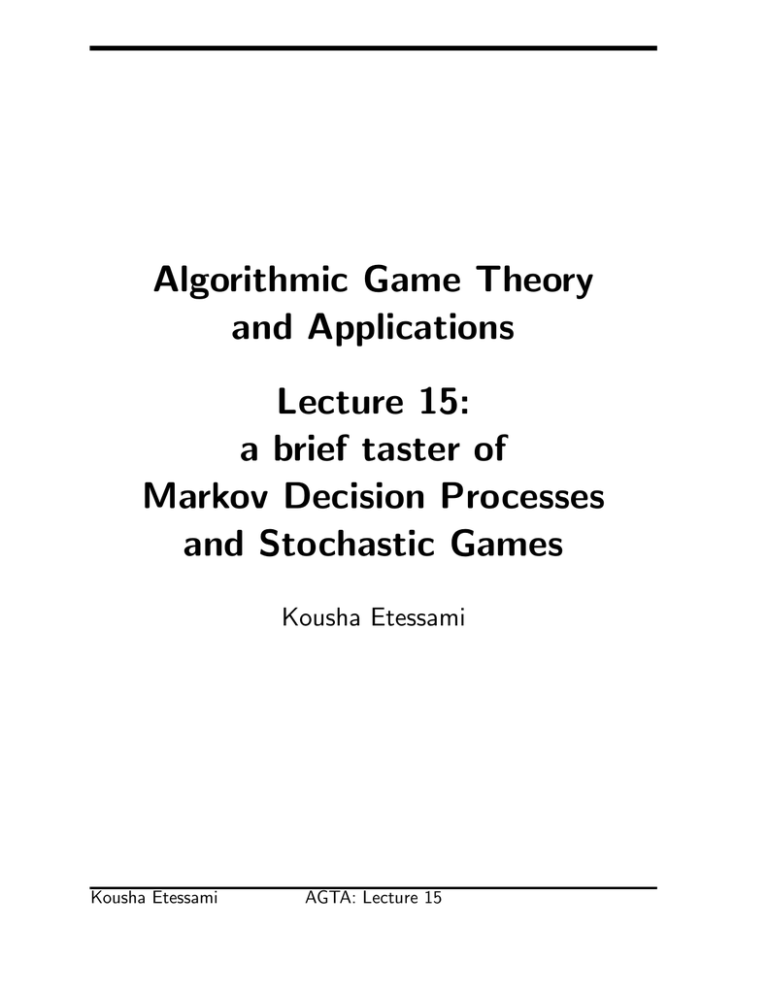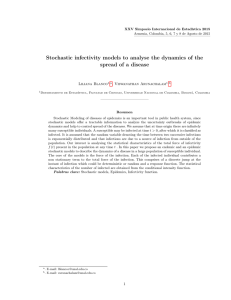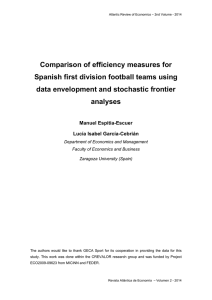a brief taster of Markov Decision Processes and Stochastic Games
Anuncio

Algorithmic Game Theory
and Applications
Lecture 15:
a brief taster of
Markov Decision Processes
and Stochastic Games
Kousha Etessami
Kousha Etessami
AGTA: Lecture 15
1
warning
• The subjects we will touch on today are so
interesting and vast that one could easily spend
an entire course on them alone.
• So, think of what we discuss today as only a
brief “taster”, and please do explore it further if
it interests you.
• Here are two standard textbooks that you can
look up if you are interested in learning more:
– M. Puterman, Markov Decision Processes,
Wiley, 1994.
– J. Filar and K. Vrieze, Competitive Markov
Decision Processes, Springer, 1997.
(This book is really about 2-player zero-sum
stochastic games.)
Kousha Etessami
AGTA: Lecture 15
2
Games against Nature
Consider a game graph, where some nodes belong to
player 1 but others are chance nodes of “Nature”:
Start
Player I:
Nature:
1/3
1/6
3
2/3
1/3
1/3
1/6
1
−2
Question: What is Player 1’s “optimal strategy”
and “optimal expected payoff” in this game?
Kousha Etessami
AGTA: Lecture 15
3
a simple finite game:
“make a big number”
k−1
k−2
0
• Your goal is to create as large a k-digit number as
possible, using digits from D = {0, 1, 2, . . . , 9},
which “nature” will give you, one by one.
• The game proceeds in k rounds.
• In each round, “nature” chooses d ∈ D “uniformly
at random”, i.e., each digit has probability 1/10.
• You then choose which “unfilled” position in the
k-digit number should be “filled” with digit d.
(Initially, all k positions are “unfilled”.)
• The game ends when all k positions are “filled”.
Your goal: maximize final number’s expected value.
Question: What should your strategy be?
This is a “finite horizon” “Markov Decision Process”.
(example taken from [Puterman’94].)
Note that this is a finite PI-game and, in principle,
we can solve it using the “bottom-up” algorithm.
But we wouldn’t want to look at the entire tree if we
can avoid it!
Kousha Etessami
AGTA: Lecture 15
4
vast applications
Beginning in the 1950’s with the work of Bellman,
Wald, and others, these kinds of “Games Against
Nature”, a.k.a., “Markov Decision Processes”, a.k.a.
“Stochastic Dynamic Programs”, have been applied
to a huge range of subjects.
Examples where MDPs have actually been applied:
• highway repair scheduling.
• inventory management.
• bus engine replacement.
• packet routing in telephone networks.
• waste management.
• call center scheduling
• mating and mate desertion in hawks (don’t ask).
• hunting behavior of lions
(don’t ask).
• egg laying patterns of “apple magots” (don’t ask).
• medical diagnosis and prediction
(don’t ask).
• ......
(don’t ask).
(See [Puterman’94,Ross’83,Derman’72,Howard’70,Bellman’57,..])
Kousha Etessami
AGTA: Lecture 15
5
• The richness of applications shouldn’t surprise you.
• We live in an uncertain world, where we constantly
have to make decisions in the face of uncertainty
about future events.
• But we may have some information, or “belief”,
about the “likelihood” of future events.
• “I know I may get hit by a car if I walk out of my
apartment in the morning.” But somehow I still
muster the courage to get out.
• I don’t however walk into a random pub in Glasgow
and yell “I LOVE CELTIC FOOTBALL CLUB”,
because I know my chances of survival are far
lower.
Kousha Etessami
AGTA: Lecture 15
6
Markov Decision Processes
Definition A Markov Decision Process is given by
a game graph Gv0 = (V, E, pl, q, v0, u), where:
• V is a (finite) set of vertices.
• pl : V 7→ {0, 1}, maps each vertex either to player
0 (“Nature”) or to player 1.
• Let V0 = pl−1(0) , and V1 = pl−1 (1).
• E : V 7→ 2V maps each vertex v to a set E(v) of
“successors” (or “actions” at v).
• For each “nature” vertex, v ∈ V0, a probability
distribution qv : E(v) 7→P
[0, 1], over the set of
“actions” at v, such that v′∈E(v) qv (v ′ ) = 1.
• A start vertex v0 ∈ V .
• A payoff function:
u : ΨTv0 7→ R, from plays to payoffs for player 1.
Player 1 want to maximize its expected payoff.
Kousha Etessami
AGTA: Lecture 15
7
Many different payoff functions
Many different payoff functions have been studied in
the MDP and stochastic game literature. Examples:
1. Mean payoff: for every state v ∈ V , associate
a payoff u(v) ∈ R to that state. For a play
π = v0v1 v2v3 . . ., the goal is to maximize the
expected mean payoff:
Pn−1
i=0 u(vi )
E(lim inf
)
n→∞
n
2. Discounted total payoff: For a given discount
factor 0 < β < 1, the goal is to maximize:
E( lim
n→∞
n
X
β iu(vi))
i=0
3. Probability of reaching target: Given a target
state vT ∈ V , the goal is to maximize (or
minimize) the probability of reaching vT . This can
be rephrased as follows: for a play π = v0v1v2 . . .,
let χ(π) := 1 if vi = vT for some i ≥ 0.
Otherwise, let χ(π) := 0. Then the goal is to
maximize/minimize:
E(χ(π))
Kousha Etessami
AGTA: Lecture 15
8
Expected payoffs
• Intuitively, we want to define expected payoffs
as the sum of payoffs of each play times its
probability.
• However, of course, this is not possible in general
because after fixing a strategy it may be the case
that all plays are infinite, and every infinite play
has probability 0!
• In general, to define the expected payoff for a
fixed strategy requires a proper measure theoretic
treatment of the probability space of infinite plays
involved, etc.
• This is the same thing we have to do in the theory
of Markov chains (where there is no player).
• We will avoid all the heavy probability theory.
(You have to take it on faith that the intuitive
notions can be formally defined appropriately, or
consult the cited textbooks.)
Kousha Etessami
AGTA: Lecture 15
9
memoryless optimal strategies
A strategy is again any function that maps each
history of the game (ending in a node controlled by
player 1), to an action (or a probability distribution
over actions) at that node.
Theorem (memoryless optimal strategies) For every
finite-state MDP, with any of the the following
objectives:
1. Mean payoff,
2. Discounted total payoff, or
3. Probability of reaching target,
player 1 has a pure memoryless optimal strategy.
In other words, player 1 has an optimal strategy
where it just picks one edge from E(v) for each
vertex v ∈ V1.
(For a proof see, e.g., [Puterman’94].)
Kousha Etessami
AGTA: Lecture 15
10
computing optimal values via LP
For the objective maximize probability to reach
target vT , consider the following LP. Let V =
{v1, . . . , vn} be the vertices of Gv . We will have
one LP variable xi for each vertex vi ∈ V .
Pn
Minimize i=1 xi
Subject to:
xT = 1;
xi ≥ xj , for each vi ∈ V1, and vj ∈ E(vi );
P
xi = vj ∈E(vi) qvi (vj ) ∗ xj , for each vi ∈ V0;
xi ≥ 0 for i = 1, . . . , n.
Theorem For (x∗1 , . . . , x∗n) ∈ Rn an optimal solution
to this LP (which must exist), each x∗i is the optimal
value for player 1 in the game Gvi .
We have all the ingredients to prove this, but no time.
See [Puterman’94, Courcoubetis-Yannakakis’90].
Question: The LP gives us the optimal value, but
where’s the optimal strategy?
Kousha Etessami
AGTA: Lecture 15
11
extracting the optimal strategy
Suppose you have computed the optimal values x∗
for each vertex.
How do you find an optimal (memoryless) strategy?
One way to find an optimal strategy for player 1 in
this MDPs is to solve the dual LP.
It turns out that an optimal solution to the dual LP
encodes an optimal strategy of player 1 in the MDP
associated with the primal LP. And, furthermore, if
you use Simplex, the optimal basic feasible solution to
the dual will yield a pure strategy. Too bad we don’t
have time to see this. (see, e.g., [Puterman’94].)
Kousha Etessami
AGTA: Lecture 15
12
Stochastic Games
What if we introduce a second player in the game
against nature?
In 1953 L. Shapley, one of the major figures in game
theory, introduced “stochastic games”, a general
class of zero-sum, not-necessarily perfect info, twoplayer games which generalize MDPs. This was
about the same time that Bellman and others were
studying MDPs.
In Shapley’s stochastic games, at each state, both
players simultaneously and independently choose an
action. Their joint actions yield both a 1-step reward,
and a probability distribution on the next state.
We will confine ourselves to a restricted perfect
information stochastic games where the objective is
the probability of reaching a target.
These are callled “simple stochastic games” by
[Condon’92]. (Condon restricts to win-lose games,
but she points out the generalization to zero-sum.)
Kousha Etessami
AGTA: Lecture 15
13
simple stochastic games
Definition A zero-sum simple stochastic game is
given by a game graph Gv0 = (V, E, pl, q, v0, u),
where:
• V is a (finite) set of vertices.
• pl : V →
7 {0, 1, 2}, maps each vertex to one of
player 0 (“Nature”), player 1, or player 2.
• Let V0 = pl−1(0), V1 = pl−1(1), & V2 = pl−1 (2).
• E : V 7→ 2V maps each vertex v to a set E(v) of
“successors” (or “actions” at v).
• Let Vdead = {v ∈ V | E(v) = ∅}.
• For each “nature” vertex, v ∈ V0, a probability
distribution qv : E(v) 7→P
[0, 1], over the set of
“actions” at v, such that v′∈E(v) qv (v ′ ) = 1.
• A start vertex v0 ∈ V .
• A target vertex vT ∈ V .
Kousha Etessami
AGTA: Lecture 15
14
memoryless determinacy
• The goal of player 1 is to maximize the probability
of hitting the target state vT .
• The goal of of player 2 is to minimize this
probability. (So, the game is a zero-sum 2-player
game.)
• We call the game memorylessly determined if both
players have (deterministic) memoryless optimal
strategies.
Theorem([Condon’92]) Every simple stochastic
game is memorylessly determined.
Kousha Etessami
AGTA: Lecture 15
15
computing optimal strategies
• Memoryless determinacy immediately gives us one
algorithm for computing optimal strategies:
– “Guess” the strategy for one of the two players.
– The “residual game” is a MDP.
Solve the corresponding LP.
• This gives a NP ∩ co-NP procedure for solving
simple stochastic games.
• [Hoffman-Karp’66] studied a “strategy improvement
algorithm” for stochastic games based on LP,
which can be adapted to simple stochastic games
([Condon’92]).
Strategy improvement works well in practice, but
recent results show that this algorithm requires
exponential time for both MDPs and stochastic
games, with SOME objective functions.
• Is there a P-time algorithm for solving simple
stochastic games? This is an open problem.
• It turns out that solving parity games and
mean payoff games (Lecture 13) can be efficiently
reduced to solving simple stochastic games (see,
e.g., [Zwick-Paterson’96]).
Kousha Etessami
AGTA: Lecture 15
16
food for thought
What is the relationship between computing
Nash Equilibria in finite (two-person, n-person)
strategic games and computing solutions to
(simple) stochastic games?
In other words:
What does Nash have to do with Shapley?
Nash and Shapley were friends in grad school when
game theory was being founded, but that’s obviously
not what I mean!
To put it more concretely: is either computational
problem efficiently reducible to the other?
THIS QUESTION HAS BEEN ANSWERED: we now
know that both computing the value of Simple
Stochatic Games, and approximating the (irrational)
value of Shapley’s Stochastic Games are reducible to
computing a NE in 2-player strategic games.
(See [Etessami-Yannakakis,’07,SICOMP’10]).
Kousha Etessami
AGTA: Lecture 15


